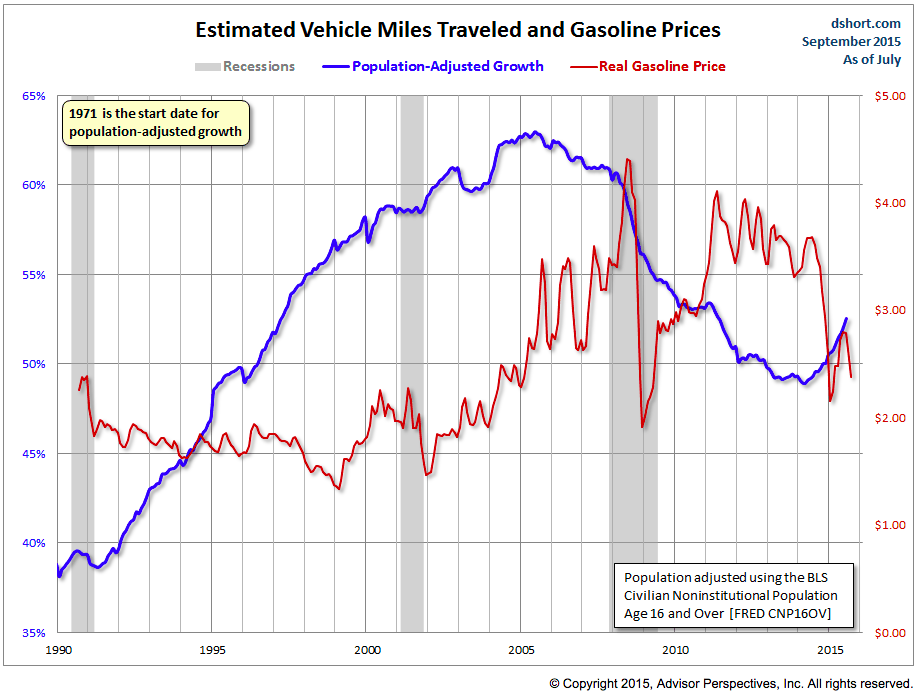A little over a year ago, a gallon of regular gasoline cost $3.70. Since then, that price has plummeted, and remains more than a dollar cheaper than it was through most of 2014.
Over the same period, there’s been a small but noticeable uptick in driving in the US. After nearly a decade of steady declines in vehicle miles traveled per person, car use has suddenly pushed upwards. Average miles traveled per person, which were 25.7 a year ago, have jumped up to 26.4 in July—the first sustained increase in driving in more than a decade.
Some in the highway community have heralded the growth in driving in recent months as a sign that we need to invest much more in road construction.
The increase isn’t very big, however. In historic terms, Americans are now driving at about the same rate as they were in 2000. It would take nearly a decade of growth at the current rate of expansion just to get back to the level of driving of 2004. But there’s little reason to believe anything like that is in the cards.
During the long period of driving declines, many were tempted to dismiss gas prices as a factor in shaping driving behavior, arguing instead that the decline was solely due to demographics, changing tastes, improved communication technology, and American’s falling out of love with cars. All of these trends were in play, but it’s clear now, as it should have been then, that price matters.
Nevertheless, highway advocates have predictably seized on the uptick in driving to claim that we need to throw a lot more money at road widening projects. Does the upsurge in driving really signal an end to the millennial abandonment of motoring? Is there a renewed “love affair” with automobile?
We would argue no: The cultural explanations of the driving trends have to be read in the context of prices. Millennials coming of age in the era of $4.00 a gallon gas behave very differently than baby boomers who paid 29 cents a gallon.
For some people, however, this is not obvious: they look at the trends in gas prices and vehicle miles traveled (VMT) and conclude that there’s little correlation. The very sharp Doug Short at Adviser Perspectives, argues, for example, that “the correlation is fairly weak over the entire timeframe.” Similarly analysts at the State Smart Transportation Institute argued that: “There is no clear evidence that fuel prices have distinctly influenced driver behavior during the past decade”
But “price elasticity”—the way that people change their consumption behavior in response to how much something costs—still matters. The fact that driving has risen as gas prices fall is far from a coincidence. In fact, evidence shows that Americans react to higher gas prices by driving less—and to lower gas prices by driving more.

It’s important to remember that there’s no reason to expect the reaction to changing gas prices to be instantaneous. An axiom of economics is that elasticities are larger in the long run than the short run. People make so many decisions (where to live and work, whether to own a car, etc) that can’t be changed immediately. Likewise, perceptions and expectations about future price changes make a big difference: Few people anticipated the advent of $4.00 per gallon gasoline in the early 2000s. The technical challenge with estimating price elasticities is that analysts have a hard time sorting out short term and long term effects (prices change rapidly, behavior much more slowly), and many of the changes in prices are either too small to be noticed by consumers or short-lived. As a result, the reaction to price changes plays out slowly, over time—the decline in VMT per capita after 2008 continued right through 2013, even though prices were not increasing above their previous peaks.
But while it may be attenuated, and play out gradually over time, there is still a behavioral response to changing prices. Already, there’s evidence that the decline is gas prices has produced a change in the kind of vehicles we’re buying. The sales-weighted average fuel economy of new vehicles, which has been steadily rising, and reached a high of 25.8 miles per gallon in the summer of 2014, has fallen by 2.3 percent to 25.2 miles per gallon today, according to researchers at the University of Michigan. Because of the long life of vehicles, lower fuel economy gets “baked into the cake”: meaning that lower fuel prices today produce greater fuel consumption and more emissions for years to come.
And while there may be a break in the longer-term decline in VMT per capita, there’s little reason to believe that we’ll see a return to the long term growth path that prevailed in the 1980s and 1990s—growth that many transportation departments’ forecasts still cling to.
It’s certainly true that demographics (an aging population), changes in tastes (the growing preference for urban living, biking and walking), and technology (the ability to use telecommunications to reduce trip taking) will all continue to contribute to a diminished demand for driving. But prices still matter. What we’re embarking on, courtesy of a highly volatile and unpredictable global market for petroleum, is a very interesting experiment to find out exactly how much—in economics terms, to discover the price elasticity of demand for driving. We’ll be watching to see the results.

